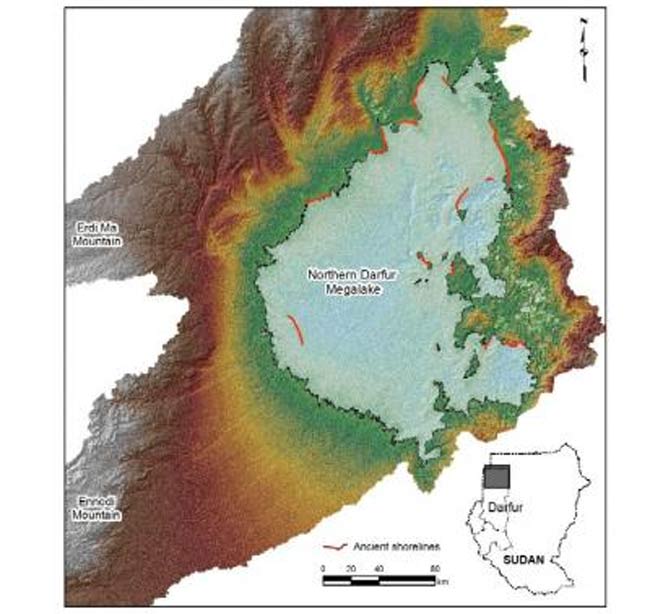Ancient Mega-Lake Discovered in Darfur

Scientists using radar techniques have peeled away the sandy cloak blanketing Darfur’s parched landscape to reveal an ancient basin that once housed a mega-lake larger than Lake Erie.
“When you go into these deserts and you look at the land, it’s so dry and lifeless you think there has never been anything alive there. Then you look in the past, and you see there were rivers and lakes,” said study team member Farouk El-Baz, director of Boston University Center for Remote Sensing.
Dubbed the Northern Darfur Mega-lake, the large pool of water is estimated to have sprawled over nearly 12,000 square miles during its heyday, with 600 cubic miles of water when filled to the brim.
Hidden pool
El-Baz and his colleague Eman Ghoneim, also of the Center for Remote Sensing, discovered the lake by analyzing images from the satellite Radarsat, which used radar waves to penetrate the fine-grained sand in western Sudan, revealing the hidden contours of the lake basin and surrounding rivers.
They also collected elevation information, finding that segments of the lake’s shoreline are about 1,900 feet above sea level. With the data, they were able to reconstruct what the lake and the rivers that emptied into it may have looked like in the past.
This reconstruction will be detailed in an upcoming issue of the International Journal of Remote Sensing.
Sign up for the Live Science daily newsletter now
Get the world’s most fascinating discoveries delivered straight to your inbox.
Water savers
The watery find sheds light on the past climate in the Sahara region.
While the researchers are not sure of the lake’s age, its substantial size suggests it was around for a long while, fed by plentiful rainfall.
“This ancient lake, which represents indisputable evidence of the past rainy conditions in the eastern Sahara, will have significant consequences for improving our knowledge of continental climate change and regional paleo-hydrology,” Ghoneim said.
The scientists had previously discovered a similar lake basin just tens of miles north of the one-time Darfur lake. They found artifacts such as hunting knives and axes in the area, suggesting the region was a savannah-like environment where humans once lived. The scientists think the Northern Darfur Mega-lake might have once been a similar habitat.
Though the lake has since dried up, its water likely percolated into the surrounding sand and is now part of the groundwater. Maps of the ancient lake could help with groundwater exploration efforts in the Darfur region, where access to fresh water is both scarce and essential for refugee survival.
“The likelihood of groundwater to exist in huge amounts is almost certain, so why not explore it for groundwater to help these refugees and the people who live in Darfur?” El-Baz told LiveScience.
- Images: Earth as Art
- 101 Amazing Earth Facts
- Top 10: How Weather Changed History
Jeanna Bryner is managing editor of Scientific American. Previously she was editor in chief of Live Science and, prior to that, an editor at Scholastic's Science World magazine. Bryner has an English degree from Salisbury University, a master's degree in biogeochemistry and environmental sciences from the University of Maryland and a graduate science journalism degree from New York University. She has worked as a biologist in Florida, where she monitored wetlands and did field surveys for endangered species, including the gorgeous Florida Scrub Jay. She also received an ocean sciences journalism fellowship from the Woods Hole Oceanographic Institution. She is a firm believer that science is for everyone and that just about everything can be viewed through the lens of science.









